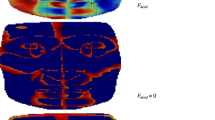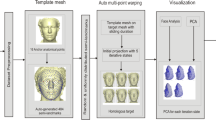Abstract
The face is perhaps the most important human anatomical part, and its study is very important in many fields, such as the medical one and the identification one. Technical literature presents many works on this topic involving bi-dimensional solutions. Even if these solutions are able to provide interesting results, they are strongly subjected to images distortion. Thanks to the significant improvements obtained in the 3D scanner domain (photogrammetry for instance), today it is possible to replace the 2D images with more precise and complete 3D models (triangulated points clouds). Working on three-dimensional data, in fact, it is possible to obtain a more complete set of information about the face morphology. At present, even if it is possible to find interesting papers on this field, there is the lack of a complete protocol for converting the big amount of data coming from the three-dimensional point clouds in a reliable set of facial data, which could be employed for recognition and medical tasks. Starting from some anatomical human face concepts, it has been possible to understand that some soft-tissue landmarks could be the right data set for supporting many processes working on three-dimensional models. So, working in the Differential Geometry domain, through the Coefficients of the Fundamental Forms, the Principal Curvatures, Mean and Gaussian Curvatures and also with the derivatives and the Shape and Curvedness Indexes, the study has proposed a structured methodology for soft-tissue landmark formalization in order to provide a methodology for their automatic identification. The proposed methodology and its sensitivity have been tested with the involvement of a series of subjects acquired in different scenarios.



































Similar content being viewed by others
References
Alker M, Frantz S, Rohr K, Stiehl HS (2001) Improving the robustness in extracting 3D point landmarks from 3D medical images using parametric deformable models. Lect Notes Comput Sci 2208:582–590, Springer-Verlag
Ansari A, Abdel-Mottaleb M (2005) Automatic facial feature extraction and 3D face modeling using two orthogonal views with application to 3D face recognition. Pattern Recogn 38:2549–2563, Elsevier
Berretti S, Amor BB, Daoudi M, Del Bimbo R (2011) 3D facial expression recognition using SIFT descriptors of automatically detected keypoints. The Vis Comput 27:1021–1036, Springer
Bickel B, Lang M, Botsch M, Otaduy MA, Gross M (2008) Pose-Space animation and transfer of facial details. Proceedings of the 2008 ACM SIGGRAPH/Eurographics Symposium on Computer Animation
Blanz V, Vetter T (2008) A morphable model for the synthesis Of 3D faces. Proceedings of the 26th Annual Conference on Computer Graphics and Interactive Techniques 187–194
Calignano F (2009) Morphometric methodologies for bio-engineering applications. PhD Degree Thesis, Politecnico di Torino, Department of Production Systems and Business Economics
Cyberware color 3D digitizer product information. Cyberware Inc. Monterey CA, USA
D’Hose J, Colineau J, Bichon C, Dorizzi B (2007) Precise localization of landmarks on 3D faces using Gabor wavelets. First IEEE International Conference on Biometrics: Theory, Applications, and Systems, 1–6
Do Carmo M (1976) Differential geometry of curves and surfaces. Prentice-Hall Inc, Englewood Cliffs
Frantz S, Rohr K, Stiehl HS (1998) Multi-Step Procedures for the Localization of 2D and 3D Point Landmarksand Automatic ROI Size Selection. Lect Notes Comput Sci 1406:687–703, Springer-Verlag
Frantz S, Rohr K, Stiehl HS (1999) Improving the detection performance in semi-automatic landmark extraction. Lect Notes Comput Sci 1679:253–262, Springer-Verlag
Frantz S, Rohr K, Stiehl HS (2000) Localization of 3D anatomical point landmarks in 3D tomographic images using deformable models. Lect Notes Comput Sci 1935:492–501, Springer-Verlag
Frantz S, Rohr K, Stiehl HS (2005) Development and validation of a multi-step approach to improved detection of 3D point landmarks in tomographic images. Image Vis Comput 23(11):956–971, Science Direct
Gray A, Abbena E, Salamon S (2006) Modern differential geometry of curves and surfaces with mathematica. CRC Press, Boca Raton
Koenderink JJ, Van Doorn AJ (1992) Surface shape and curvature scales. Image Vis Comput 10(8):557–564
Mortara M, Patané G, Spagnuolo M (2006) From geometric to semantic human body models. Comput Graph 30:185–196, Elsevier
Romero M, Pears N (2009) Landmark localisation in 3D face data. 6th IEEE International Conference on Advanced Video and Signal Based Surveillance, 73–78
Romero M, Pears N (2009) Point-pair descriptors for 3D facial landmark localisation. IEEE 3rd International Conference on Biometrics: Theory, Applications, and Systems, 1–6
Ruiz MC, Illingworth J (2008) Automatic landmarking of faces in 3D - ALF3D. 5th International Conference on Visual Information Engineering - IEEE Conferences, 41–46
Salah AA, Akarun L (2006) Gabor factor analysis for 2D + 3D facial landmark localization. IEEE 14th Signal Processing and Communications Applications, 1–4
Sang-Jun P, Dong-Won S (2008) 3D face recognition based on feature detection using active shape models. International Conference on Control, Automation and Systems - IEEE Conferences, 1881–1886
Wörz S, Rohr K (2005) Localization of anatomical point landmarks in 3D medical images by fitting 3D parametric intensity models. Med Image Anal 10(1):41–58, Science Direct
Author information
Authors and Affiliations
Corresponding author
Appendix 1 – Coefficients of the fundamental forms
Appendix 1 – Coefficients of the fundamental forms
Since a patch can be written as an n-tuple of functions
the partial derivative of x with respect to u can be defined by
The other partial derivatives are defined similarly.
It is possible to measure distances on a surface. In Euclidean space ℜn, if \( \underline p = \left( {{p_1},...,{p_n}} \right) \) and \( \underline q = \left( {{q_1},...,{q_n}} \right) \) are points in ℜn, then the distance s from \( \underline p \) to \( \underline q \) is given by
Because a general surface is curved, distance on it is not the same as in Euclidean space; in particular, the form above is in general false however the coordinates are interpreted. To describe how to measure distance on a surface, the mathematically imprecise concept of an “infinitesimal” is necessary. The infinitesimal version of that for n = 2 for a surface is
called First Fundamental Form, or Riemann Metric. This is the classical notation for a metric on a surface. E, F, G are functions U → ℜ such that:
and they are called Coefficients of the First Fundamental Form. These coefficients are given by inner products of the partial derivatives of the surface. Therefore, the First Fundamental Form is merely the expression of how the surface inherits the natural inner product of ℜ3. Geometrically, the first fundamental form allows to make measurements on the surface (lengths of curves, angles of tangent vectors, areas of regions) without referring back to the ambient space ℜ3 where the surface lies [9].
To introduce the Second Fundamental Form, the definitions of Gauss map must be given. For an injective patch x: U → ℜn the unit normal vector field or surface normal N is defined by
at those points \( \left( {u,v} \right) \in U \) at which \( {x_u} \times {x_v} \) does not vanish [14]. The Gauss Map is the map which assigns to each point p on a surface the point on the unit sphere \( {S^2}(1) \subset {\Re^3} \) that is parallel to the unit normal N(p), or N p.
Let x: U → ℜn be a regular patch. Then
are called the Coefficients of the Second Fundamental Form of x, and \( ed{u^2} + 2fdudv + gd{v^2} \) is the Second Fundamental Form of the patch x.
Usually a surface is given as the graph of a differentiable function z = h(x, y), where (x, y) belong to an open set U → ℜ2. It is, therefore, convenient to have close at hand formulas for the relevant concepts in this case. To obtain such formulas let us parametrize the surface by
where u = x, v = y. A simple computation shows that
Thus
is a unit normal field on the surface, and the Coefficients of the Second Fundamental Form in this orientation are given by
From the expressions above, any needed formula can be easily computed. For instance, the Coefficients of the First Fundamental Form are obtained:
Rights and permissions
About this article
Cite this article
Vezzetti, E., Marcolin, F. Geometry-based 3D face morphology analysis: soft-tissue landmark formalization. Multimed Tools Appl 68, 895–929 (2014). https://doi.org/10.1007/s11042-012-1091-3
Published:
Issue Date:
DOI: https://doi.org/10.1007/s11042-012-1091-3




